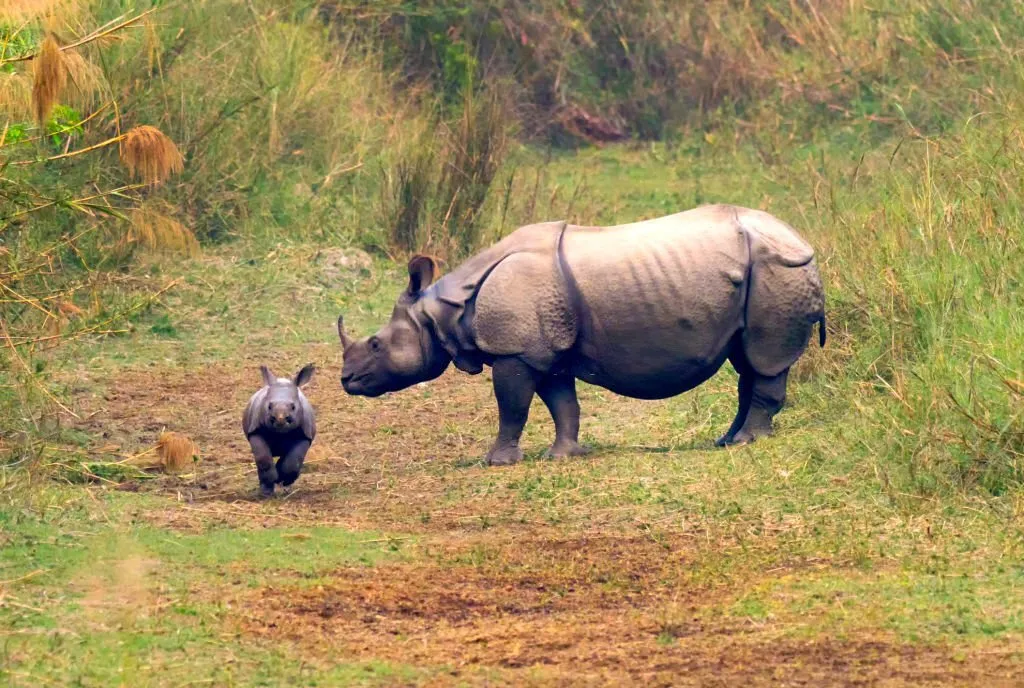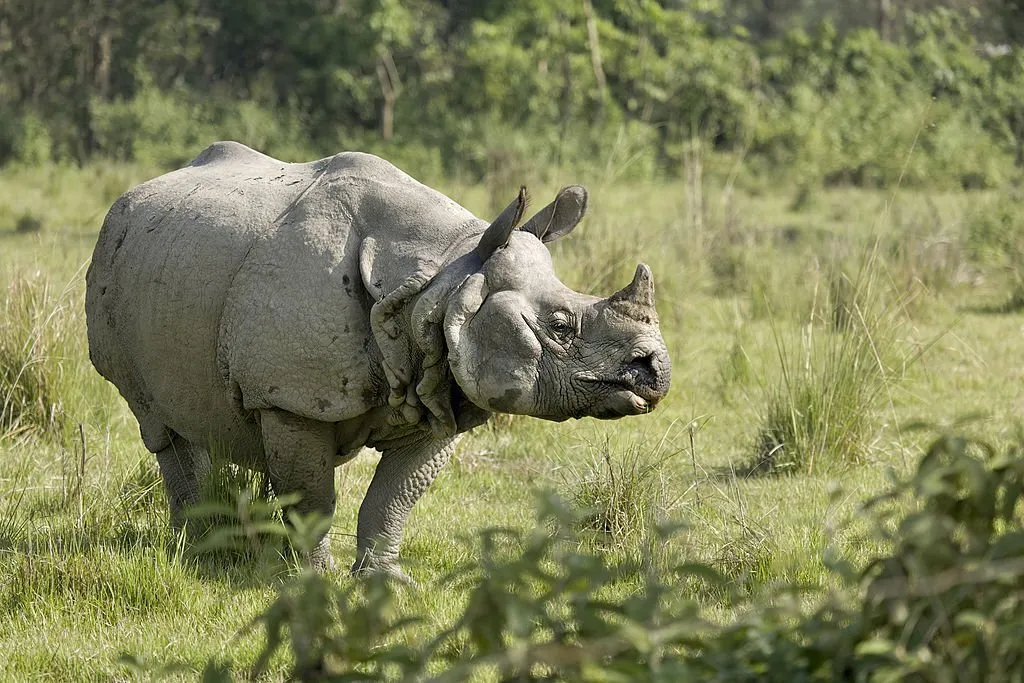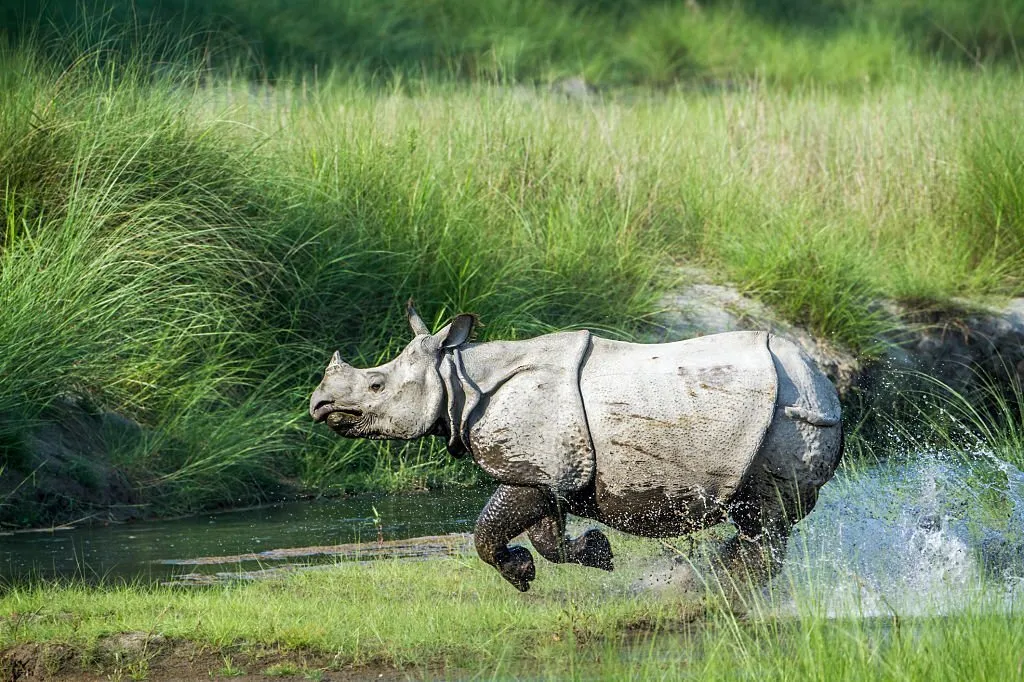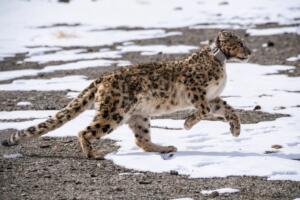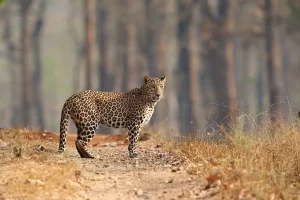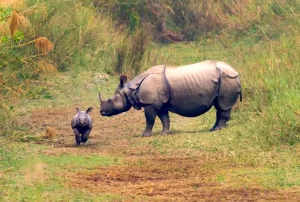1. Introduction to Indian One-Horned Rhino
One of Earth’s most magnificent creations is the enormous Himalayas. The existence of the Himalayas is correlated with the existence of various forms of life there. The Himalayas, which range in height from the highest to the lowest, provide us with a very diverse range of wildlife. One of the most fertile regions on the planet is being created by the sediments and alluvial soil that have been eroded and accumulated in the foothills of the Himalayas over millions of years.
The Terai region is a part of northern India that stretches from the Yamuna river eastward through the states of Haryana, Uttarakhand, Uttar Pradesh, Bihar, West Bengal, and the Southern Grasslands of Nepal. The Dooars are the equivalent lowlands in the Brahmaputra river basin that have the same habitat as West Bengal, Bhutan, and Assam and have dense flora and tall grasses. Some of the largest creatures in the world live there because of the area’s lush foliage. The largest land animal in the world, the Asiatic Elephant, the One-Horned Rhinoceros, the Asiatic Water Buffalo, and countless ungulates with more than 800 species of birds are just a few of them.
The region is also home to the sole remaining herd of one-horned rhinoceroses in the entire globe as well as the soft-ground barasingha. India is home to around 80% of the world’s one-horned rhinoceros.
Currently, India is home to roughly 3000 of the world’s remaining 3700 Greater One-horned Rhinoceros.
2. Description of Indian One-Horned Rhino
The White Rhino from Africa is the largest rhinoceros in the world, while the One Horned Rhino, often known as the Indian Rhino, is the second largest. The White and Black Rhinos, two African species, and the Javan and Sumatran Rhinos, two Asian species, make up the other four species.
However, now the White Rhino population in the wild has got vanished we can say the Indian Rhino is the largest Rhinoceros species in the world now. The body of the Indian Rhino is armored to resemble an ancient animal with thick, folded skin that is dark grey on the outside and pinkish on the inside. It has very little hair, some hair at the tip of the tail, hair in the ear fringes, and hair in the eyelashes. There are pimples that resemble warts on the top portion of the legs, shoulders, and back. The single horn located just above their snouts is oriented slightly backward on both males and females. The male has a significant skin fold on his neck.
The average length of a male one-horned rhinoceros, including the head, is around 12 feet, while the average length of a female, including the head, is slightly shorter at about 11 feet. One-horned rhinoceros males can reach heights of up to 6 feet from the ground to the shoulders, while females typically reach heights of about 5.5 feet.
The One-Horned Rhinoceros is Asia’s second-largest native terrestrial mammal, after the Asiatic Elephant. An average male can weigh up to 2200 kg (4850 lb), whereas an average female weighs about 1600 kg (3530 lb).
Explore Tiger & One-Horned Rhino Safari Tour in India
3. Distribution and Habitat of Indian One-Horned Rhino
The Greater One-Horned Rhinoceros can only be found in its natural habitat in India and Nepal. One of the well-known national parks in the state of Assam, in the northeastern region of India, is Kaziranga National Park. Other places to see this magnificent species include the Jaldapara National Park in West Bengal, the Manas National Park in Assam yet again, and the Dudhwa National Park in Uttar Pradesh.
Because one-horned rhinoceros are huge mammals with larger dietary requirements, they reside in the lush foliage of the Himalayan foothills. The optimum habitat is on tall grasslands that are surrounded by wetlands. The availability of water in their immediate environment is necessary for their feeding behavior with aquatic plants.
More about the Kaziranga National Park
Images of animals, birds, flowers, and large rolling stretches of natural grasslands come to mind when you think of the Kaziranga National Park, which is surrounded by the Brahmaputra River to the north and the beautiful hills of Karbi Anglong to the south. Kaziranga is one of a kind.
Indian Rhino and Wild Buffalo are so abundant in this area that no tourist who spends even a day there will leave without seeing these two species. Additionally, he will encounter a wide variety of fauna and avifauna.
The Park has a basic oval form and measures around 430 sq km (166 sq mi) in total area, with a length of about 50 km (31 mi) and a width of about 16 km (10 mi) at its widest point.
Due to recent expansion, the park’s overall area now exceeds 860 square kilometers. Located on the Brahmaputra’s southern bank, its southern limit roughly follows the Mori Difaloo River, which runs close to and parallels to National Highway No.37, the state’s primary artery. Several smaller streams from the Karbi Anglong Hills make their way down to the beels and the two other rivers that flow through it, Difaloo and Bhengrai. The landscape consists primarily of wetlands, open forest, streams, beel, and reed beds, and high, coarse grasses (often collectively called elephant grass) that reach heights of 5 m or more. Water-hyacinth, a plant not native to the Park but was imported there for whatever reason, has become a prominent feature of numerous beels. The Karbi Anglong Hills, which rise to almost 4000 feet to the south of the highway, are of particular importance to the park since it is here that animals go to escape the monsoon floods that cover nearly the entire park.
4. The behavior of the Indian One-Horned Rhino
Except for mothers and calves, greater one-horned rhinoceroses live solitary. A calf would remain with its mother for three to four years; occasionally, it would stay for close to five years. Despite being rumored to be lonely, they may be seen together in April, the hottest month of the year, when there is a shortage of water. I’ve seen ten rhinoceroses congregated in a single pool of water. Males live alone in a loosely defined territory that they fiercely defend, which may overlap with the territories of other males. The territories are impacted by the seasonality of food supply. The entrance and exit from these zones are completely unrestricted for females. When there is an abundance of food in an area, it is typical to see several animals grazing together.
Male Greater one-horned rhinos engage in fierce competition for their ideal environment. It is not unusual for a single male to pass away in one of these fights; often, this happens a few days after the fight as a result of injuries received during the conflict.
The larger One-horned Rhino dung mounds, commonly referred to as “Middens,” serve as centres of communication and boundary markers. Animals will commonly urinate in the same place with other animals. This much excrement can form a mound that is 05 metres wide and 1 metre tall. Greater one-horned rhinos urinate and then scratch their hind feet in the waste. By continuing to move, they “transfer” their scent along the routes, leaving a scent trail that the rhino can follow to claim the territory.
Similar to some of the other species, one-horned rhinos wallow in mud. They occasionally, especially in the summer, have mud painted all over their bodies, which keeps them cool and also helps them get rid of ticks and fleas.
Popular Tiger & Rhino Safari Tour of India
5. Courtship of Indian One-Horned Rhino
The Greater One-Horned Rhino or the Indian rhinos are reticent breeders, which means that the male and female may not always have the same preferences for courtship and mating behaviour. Males experience a period of heat as females do, and these stages must coincide for mating to occur.
Before mating, rhinos engage in a complicated ritual known as a courtship that creates a social and sexual bond between the individuals. Bulls and cows can have relationships that last for several days or even weeks. A female in heat will shoot pee intermittently and produce distinctive rutting noises to entice a male. Low-pitched, frequently accompanied by a long sigh, and resembling a groaning noise without nasal exhalations, these mating screams are distinctive.
Although they were fleeting, the mating cries heard in RRA were frequent; each bout comprised at least 10–20 calls. At the beginning of courtship, the female typically rushes toward the male and even chases him. Typically, the male trots or gallops after the female after her, just like a horse would. On occasion, the animals may confront one another and engage in combat using their horns and fangs.
After a successful courtship display, the female yields to the male’s dominance and consents to mating. The female moves her hindquarters toward the male as she steps backward in front of him. The male puts his forelegs on her rump and mounts her.
The time it takes to mate might range from 20 to 75 minutes. As soon as mating was finished, the male dismounted, and both pairs left the area where they had mated. There was no more evidence of a relationship after mating. Male and female rhinos have been observed dragging each other when mating, with the female dragging the male more than 60 meters on her back. After the gestation period of 16 months, a female gives birth to a calf.
6. The lifespan of the Indian One-Horned Rhino
In the wild, one-horned rhinoceroses often live 40 to 45 years. A mature rhinoceros has no specific predators. Even the Tiger, India’s largest predator, rarely hunts rhinos. However, when they are young or old, they are quite vulnerable.
Age of Rhinoceros & its Measurements
At Birth: No Protuberance
6 months: 1.1 to 1.65 cm
1 Year: 3.3 to 5.5 cm
2 Year: 6.6 – 8.8 cm, Basal circumference 17.6 to
22 cm
3 Year: 8.8 – 13.2 cm, Basal circumference 17.6
to 44 cm
3-20 Years: 19.8 to 22 cm, fully mature horn
25 – 30 Years: Reduction in height due to wear and
tear
7. Threats to Indian One-Horned Rhino
Habitat Loss
The removal of alluvial plain grasses is one of the key causes of the fall in the rhino population. The modern human population’s growing need for land poses a hazard to the species. Many protected areas for one-horned rhinos have reached the limit of how many people they can hold. The conflict between humans and rhinos results from rhinos leaving protected areas to hunt in nearby communities. In India and Nepal, rhinos have been known to kill people.
Illegal Wildlife Trade
Poaching for the illicit trade in rhino horn is the second biggest threat to the Greater One-horned Rhinoceros. Although there is no scientific evidence to support the effectiveness of the horn as a medicine, it is known in traditional Asian medicine to treat a variety of illnesses, including cancer, fevers, and epilepsy.
8. Conservations Techniques
The anti-poaching team and guards in protected areas have now been improved by conservationists. Currently, the Armies in Nepal are defending the rhinos. The Greater One-horned Rhinoceros’ healthy population can be reestablished thanks to the restoration of the corridors. The conservation efforts in places like India’s Kaziranga and Nepal’s Chitwan have been quite successful. These locations now assist in supplying the rhino to other regions of the nation. The rhino has been moved to an area with little human habitation. Project Rhino also greatly helped conserve rhinoceros in India.
Another strategy is working with the people to educate them about the species and explain the financial advantages of having this magnificent animal around.
Explore the popular Tiger, Elephant & Rhino Safari Tour of India.
9. Best Place to see Rhino
One of the greatest places to witness One-horned Rhinoceros in India is Kaziranga National Park, which is home to about 75% of the country’s Greater One-horned Rhinoceros. There are locations like Manas and Dudhwa where there is a possibility of witnessing a rhino. The task of finding one is made more difficult by the low number and the thick habitat.
One of the greatest sites to see the Greater One-horned Rhinoceros outside of India in Nepal is in the Chitwan and Bardia National Park in the south of the country.
10. Types of Safaris in different National Parks
Safaris in Kaziranga, Manas, Dudhwa and Jaldapara National Park is on Jeep. Morning and afternoon jeep safaris are allotted.
In Nepal apart from the Jeep safari, a Walking safari is also allowed in Chitwan and Bardia National park.
11. How to Reach Different National Parks for One-Horned Rhinoceros
Kaziranga National Park
Kaziranga National Park lies in the Northeast state of Assam. The closest airport is Jorhat around 97 km, however, the airport is connected to only Kolkata. The other closest airport to Guwahati is well connected to many cities at around 217 km from the National park.
The closest railway station to Kaziranga National Park is Furkating which is 75 km for the National park followed by Jorhat 90 km and Guwahati 200 km.
By road, Kaziranga is 200 km from Guwahati, 291 km from Shilong, 90 km from Jorhat and 50 KM from Tezpur.
Manas National Park
The nearest airport to Manas National Park is Guwahati which is around 176 km from the National Park.
The closest railway station is Barpetta Road Railway station, which is around 45 km from the National park.
By road, Manas is 176 km from Guwahati, 403 km from Kaziranga, 466 km from Darjeeling, 287 km from Shillong and 386 km from Siliguri.
Dudhwa National Park
By air, the nearest airport is Lucknow which is 238 km from the National Park.
The closest railway station is Dudhwa Railway station which is just around 04 km from the Park Gate. Other Railway stations are Shahjanpur railway station 112 km and Lucknow agai 238 km.
By roard the nearest town is Pali which is just around 5 km, Bareily 260 km and New Delhi 430 km.
12. Best Time to visit the National Parks for One-Horned rhinoceros
One-horned rhinoceros is one of the mammal species which is dependent to water. They prefer to wallow and spend most of their time in and around water, feeding the aquatic plants and bathing. In summer the water holes are less and far from each other so the concentration of the Rhinoceros during peak summer is more during the summer. So March and April are the best time to see these magnificent mammals. However, the sightings are good all throughout the year. One will not get disappointed by visiting different months of the year, especially Kaziranga.
Also Read Safari in India vs Safari in Africa.
13. FAQs
Q. Which is the largest Rhinoceros in the world?
A. One-horned Rhinoceros is the largest species of Rhinoceros.
Q. How many species of Rhinoceros are there?
A. There are five species Rhinoceros in the world, White Rhino, Black Rhino, One-horned Rhinoceros, Sumatran Rhinoceros and Javan Rhinoceros.
Q. Are Rhinos Endangered?
Yes, Rhinoceros are endangered species. White Rhino is near threatened.
Q. Do rhinos have predators?
In the Indian Jungle, adult Rhinos are huge for the tigers, the old and the young calves are predated by Tigers, and the same in Africa by Lions. And Nile Crocodiles are also known to attack the Rhinos while drinking water.
Q. What is a baby Rhino called?
Baby Rhino is called a calf.
Q. Are Rhino Aggressive?
Rhinos are rarely aggressive, however, they are protective over their young ones so female with the young ones shows aggression. And a male during the mating period is aggressive.

